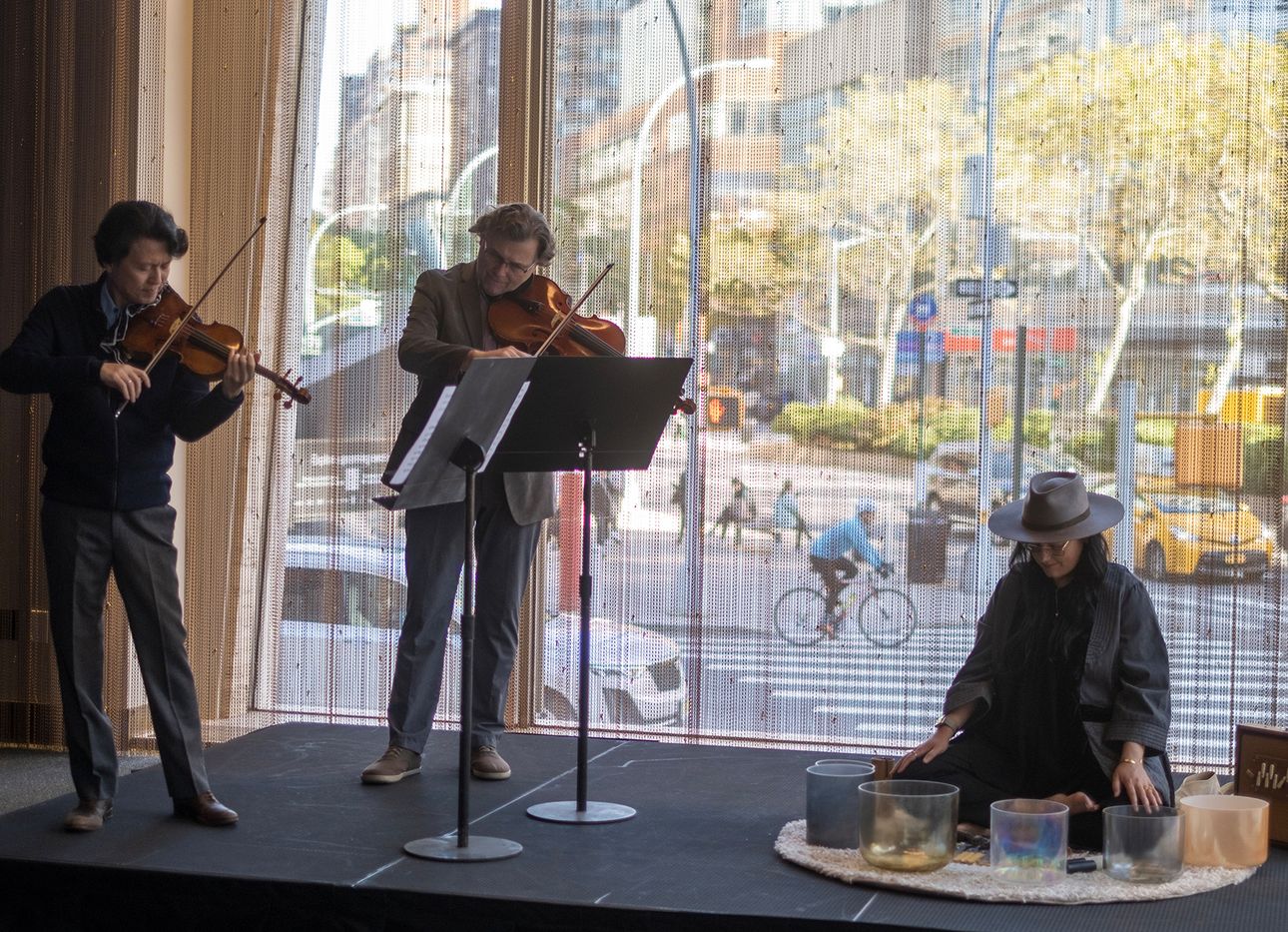
Sara Auster’s Sound Baths Are a Tonic for Our Tumultuous Times
Experiencing true silence is probably impossible. The closest I’ve come is perhaps my 30 minutes inside Doug Wheeler’s “PSAD Synthetic Desert III” (1971), an installation presented at the Guggenheim Museum in New York in 2017 that gave visitors an experience of near-soundlessness. Stepping into that carefully designed chamber at the apex of the museum’s rotunda, the air felt thick and flat, like everything had suddenly been smothered under a heavy velvet curtain. It was so silent that, after a moment, I could hear the sound of my own blood pumping. I was suddenly aware of my body in a new way. The sound of it maintaining itself was coming through a different kind of physical channel than the regular, everyday hearing I was used to. This produced a simple, but lasting revelation: Hearing, as a perceptual act, is a physical phenomenon.
This memory comes to mind as I’m speaking with Sara Auster, a world-renowned sound therapist, meditation teacher, and author. (Auster was the guest on Ep. 71 of our At a Distance podcast, and is featured in our At a Distance book.) Her work, which invites audiences to engage with sound in a holistic way, draws attention to how sound interacts with the entire body, not just the ear canal. “In my work, which is informed by somatic practices, I use the term ‘full-body listening,’ which involves engaging the senses and thinking about how we feel sound, as opposed to how we interpret it with our minds.”
This approach to sound has made Auster’s work in high demand, in a dazzling array of contexts, from New York’s Museum of Modern Art to the Palais de Tokyo in Paris. Over the course of her career, she has partnered with arts institutions, not-for-profits, hospitals, schools, and brands to explore how sound can facilitate connection and healing. The most recent of these partnerships, a series of events called “Sound Mo(ve)ments,” finds her working with members of the New York Philharmonic to stage a series of sound baths, which she defines as “deeply immersive, full-body listening experiences” that “use sound to invite gentle yet powerful therapeutic and restorative processes.” In the first in the series of free events, which took place on October 22 at the new Sidewalk Studio at David Geffen Hall, she collaborated with violist Peter Kenote and violinist Kuan Cheng Lu to expand the sound palette of her solo work.
“When the Philharmonic reached out and said they wanted to launch a wellness initiative for the ’22-’23 season, they just wanted me to do a sound bath in their new space. They weren’t even thinking about having me collaborate with musicians,” she says. “But I saw a unique opportunity to take a very important piece of their identity as an institution and integrate it into the work that I do. I wanted to show them that what we do is actually quite similar.” Blending the timbres of the Philharmonic’s string instruments into her own, which included crystal singing bowls, tuning forks, shruti and chimes, Auster integrated two understandings of sound into one undeniable physical experience.
For Auster, this desire to use sound as an integrative force is rooted in personal history. “At age 10, I lost my oldest sister to a terminal illness,” she says. “She was noncommunicative for a while, and music was a way for us to communicate with her.” Witnessing her sister’s illness and death shaped the work Auster would later make as an artist in New York. Her practice focused on “the body, how it works and how it fails us,” she says. This work would be cast in a new light when, working in her studio in 2002, at age 23, the floor collapsed and she fell to the studio below, breaking her back. As she recovered, despite the part of her that she identifies as “a New Yorker, a skeptic, rolling her eyes,” she began to explore complementary medicine practices like acupuncture and chiropractic therapy, and found that, despite her skepticism, these alternative practices helped her body and mind heal and process the trauma. Out of these explorations, she found sound therapy and realized it offered a way “to merge my artist self and my healer/teacher self into one person and one offering.”
In the coming months, Auster will continue to make her practice available in a variety of contexts. In addition to continuing the “Sound Mo(ve)ments” series with the Philharmonic, she’s offering several trainings in her methods, which will allow interested parties to facilitate their own sound baths. She’s also working with the World Health Organization to develop a course for public health leaders to build resilience through mindfulness and sound therapy. For Auster, every collaboration is a chance to share the healing power of sound with as many people as possible. “Sound ultimately helps us have a deeper relationship with ourselves, the environment, and the world around us,” an idea that sounds like a tonic for our tumultuous times.